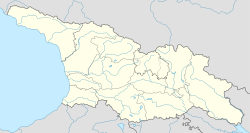
Gagra is a town in Abkhazia/Georgia, sprawling for 5 km on the northeast coast of the Black Sea, at the foot of the Caucasus Mountains. Its subtropical climate made Gagra a popular health resort in Imperial Russian and Soviet times.

The Abkhazia conflict is a territorial dispute over Abkhazia, a region on the eastern coast of the Black Sea in the South Caucasus, at the intersection of Eastern Europe and Western Asia. The conflict involves Georgia, the Russian Federation and the Russian-backed self-proclaimed Republic of Abkhazia, which is internationally recognised only by Russia, Venezuela, Nicaragua, Nauru, and Syria; Georgia and all other United Nations members consider Abkhazia a sovereign territory of Georgia. However, as of 2023, Georgia lacks de facto control over the territory.
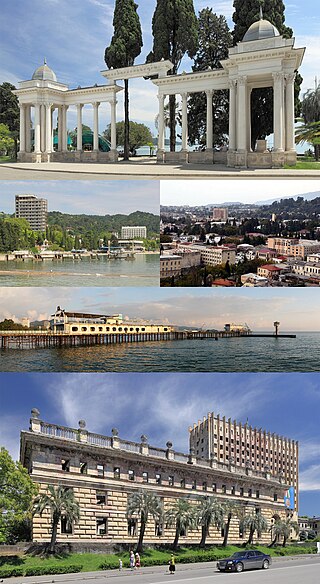
Sukhumi or Sokhumi is a city in a wide bay on the Black Sea's eastern coast. It is both the capital and largest city of the Republic of Abkhazia, a partially recognised state that most countries consider a part of Georgia. The city has been controlled by Abkhazia since the Abkhazian war in 1992–93. The city, which has an airport, is a port, major rail junction and a holiday resort because of its beaches, sanatoriums, mineral-water spas and semitropical climate. It is also a member of the International Black Sea Club.

The Bzyb or Bzipi is one of the two largest rivers of Abkhazia and the twelfth longest river in Georgia. The river valley has rich biodiversity of herbaceous garden plants, particularly in the gorge section in the upper reaches where the most prominent and colourful bellflower Campanula mirabilis with profuse growth of 100 flowers per plant is given the name, the "Queen of the Abkhazian flora". During 1904-1917 it served as the border between the Russian Empire's Sukhumi Okrug and the Black Sea Governorate.

Bzyb Mountain Range is a mountain range in Abkhazia, Georgia on the southern slope of the western part of Greater Caucasus. The ridge is about 50 km long.

Gagra Range is a mountain range of the Greater Caucasus in Abkhazia, Georgia.The range runs between the valleys of the Bzyb and Psou rivers to the south of the Caucasus Major, in a general North-South direction. The highest elevation is 3,357 m.
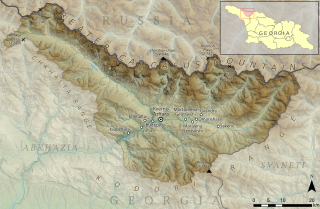
Upper Abkhazia, commonly known by its administrative name, Azhara Municipality is a geographical term and municipality of the Government of the Autonomous Republic of Abkhazia. The term was first introduced in 2006, to denote the northeastern part of the disputed territory of Abkhazia, that had remained under Georgian control after the 1992 War in Abkhazia. From September 2006 to August 2008 its main village, Chkhalta, hosted the Government of the Autonomous Republic of Abkhazia and was the seat of the Azhara municipal community. This situation came to an end in the Battle of the Kodori Valley in August 2008, when Upper Abkhazia was conquered by the Russo-Abkhazia armies, which had already controlled the rest of Abkhazia. Even though the area was no longer controlled by Georgia, the Georgian Government kept its municipal status as a sign of not recognizing any changes to the Abkhazian administrative divisions made by the breakaway republic. The current seat of the municipal government-in-exile is Tbilisi.

The history of Abkhazia, a region in the South Caucasus, spans more than 5,000 years from its settlement by the lower-paleolithic hunter-gatherers to its present status as a partially recognized state.
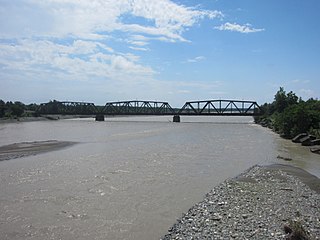
The Kodori is one of the two largest rivers of Abkhazia, along with the Bzyb. It is formed by the joining of the rivers Sakeni and Gvandra. The Kodori is first among Abkhazia's rivers with respect to average annual discharge at 144 cubic metres per second (5,100 cu ft/s) and drainage basin area at 2,051 square kilometres (792 sq mi). It is second after the Bzyb with respect to length at 105 kilometres (65 mi) when combined with the Sakeni.
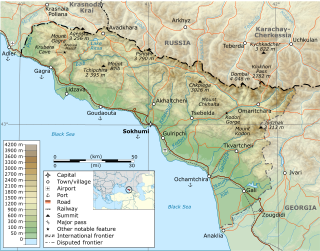
The War in Abkhazia was fought between Georgian government forces for the most part and Abkhaz separatist forces, Russian government armed forces and North Caucasian militants between 1992 and 1993. Ethnic Georgians who lived in Abkhazia fought largely on the side of Georgian government forces. Ethnic Armenians and Russians within Abkhazia's population largely supported the Abkhazians and many fought on their side. The separatists received support from thousands of North Caucasus and Cossack militants and from the Russian Federation forces stationed in and near Abkhazia.

Sukhumi District is one of the districts of Abkhazia, one of Georgia’s two breakaway republics. It corresponds to the eponymous Georgian municipality. Its capital is Sukhumi, the town by the same name, which is also the capital of entire Abkhazia. The population of the district is 11,531 according to the 2011 census. The city of Sukhumi is a separate administrative entity with 62,914 inhabitants.

During the Soviet-era, the Abkhaz ASSR was divided into six raions (districts) named after their respective capitals.

Bzyb or Bzipi is an urban-type settlement located in the Gagra District of Abkhazia, Georgia. Next to the river Bzyb. There is a 9th-10th-century church, now in ruins and a medieval fortress nearby. The town became less important when the fortress was destroyed and the town passed into the control of the clan of Inal-Ipa, which perhaps branched off around 1730 from Abkhazia's princely house, the Shervashidze.
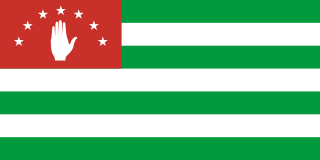
The following outline is provided as an overview of and topical guide to Abkhazia:

Abkhazia, officially the Republic of Abkhazia, is a partially recognised state in the South Caucasus, on the eastern coast of the Black Sea, at the intersection of Eastern Europe and West Asia. It covers 8,665 square kilometres (3,346 sq mi) and has a population of around 245,000. Its capital and largest city is Sukhumi.

Eshera is a village in the Sukhumi District in Abkhazia. It is a climatic-balneotherapeutic resort on the Black Sea coast, at the right side of Gumista river. Its altitude above sea level is around 30 m, the distance to Sukhumi is 16 km. Once a part of the Abkhazian ASSR of the Georgian SSR, Eshera is controlled by the de facto independent Republic of Abkhazia since 1993.

The Sukhumi or Sukhum okrug was a special administrative district (okrug) in the Caucasus Viceroyalty of the Russian Empire, part of the Kutaisi Governorate from 1883 until 1905. The administrative center of the district was the Black Sea port city of Sukhum. The okrug bordered the Kutaisi Governorate to the southwest, the Kuban Oblast to the north and the Black Sea Governorate to the northwest and in terms of its area corresponded to most of contemporary Abkhazia. During 1905–1917, the Sukhumi okrug was one of the smallest independent administrative units of the Russian Empire, second to the Zakatal okrug.
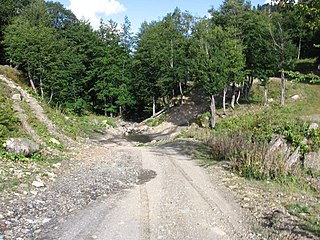
Pskhu-Gumista Strict Nature Reserve is a protected area in the Sukhumi District of Abkhazia, Georgia. The primary goal of the reserve is to protect flora and fauna of the area, including the surrounding mountainous region.
The Kelasuri or Kelasyri, also Kalashir is a river in Abkhazia, Georgia.
Aapsta is a river in Abkhazia, Georgia. It originates on the southern slopes of the Achbikhvdar ridge in the Gudauta pass area in beech forests at 1445 meters above sea level; flows into the Black Sea between the village Tskuara (Primorskoe) and the city Gudauta.

